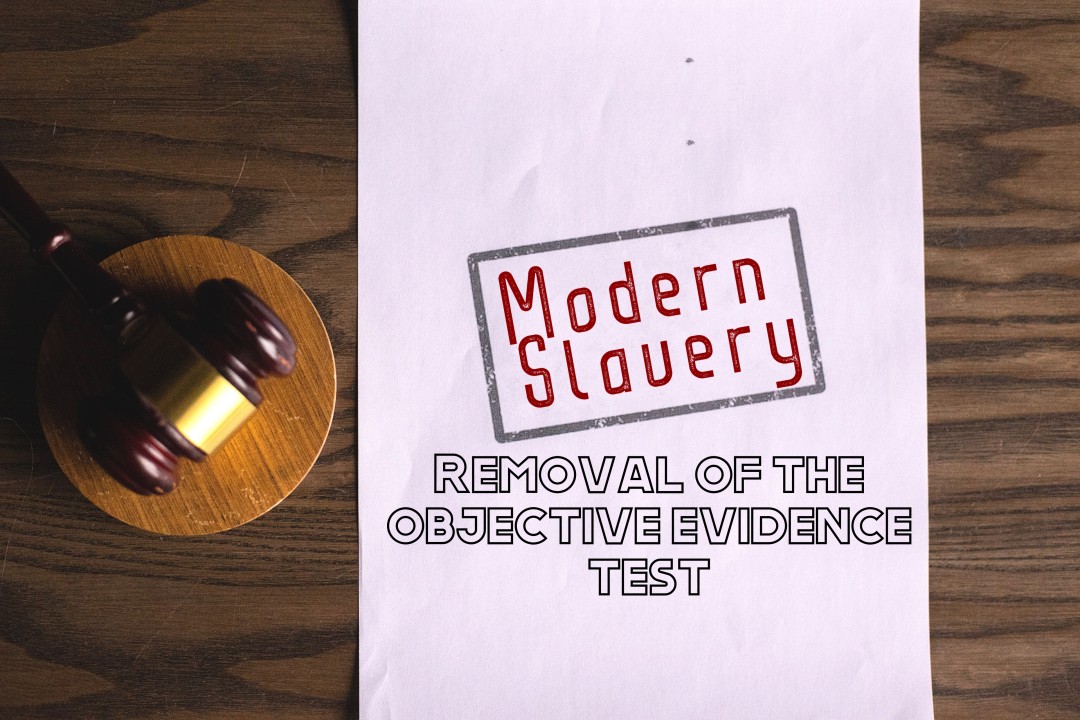In all honesty, no matter how much we write about Modern slavery, I am afraid it is never enough. This is an exceptionally complex matter, whether from a legal, social, or political perspective. Given the complexity of this issue, any changes in laws or practices can have far-reaching implications. It happened very recently, and after spending a couple of hours over the last few days reading about it, I decided to write this article.
What is modern slavery?
Article 4 of the European Convention on Human Rights prohibits slavery and forced labour. It provides:
“1. No one shall be held in slavery or servitude.
2. No one shall be required to perform forced or compulsory labour.
3. For this article, the term ‘forced or compulsory labour shall not include:
(a) any work required to be done in the ordinary course of detention imposed according to the provisions of Article 5 of the Convention or during conditional release from such custody;
(b) any service of a military character or, in the case of conscientious objectors in countries where they are recognised, service exacted instead of compulsory military service;
(c) any service exacted in case of an emergency or calamity threatening the life or well-being of the community;
(d) any work or service that forms part of normal civic obligations.“
[I encourage you to read the Guide on Article 4 of the European Convention on Human Rights]
Now we have the Modern Slavery Act 2015. However, this legislation was preceded by two relevant European sources of law. The Council of Europe Convention on Action against Trafficking in Human Beings (which drew to a considerable extent on the earlier “Palermo Protocol” to the UN Convention against Transnational Organised Crime) and Article 4 of the ECHR derive from treaties entered into by the member states of the Council of Europe.
While it will take a series of articles to give an in-depth understanding of these two sources, for today’s article, I will just highlight very specific parts of the Council of Europe Convention on Action Against Trafficking in Human Beings and Article 4.
Identification of the victims
Council of Europe Convention on Action against Trafficking in Human Beings provides a mechanism for identifying the victims.
Article 10 provides the primary instrument of the process to identify the victims.
Article 10: Identification of the Victims
Each Party shall provide its competent authorities with persons who are trained and qualified in preventing and combating trafficking in human beings, in identifying and helping victims, including children, and shall ensure that the different authorities collaborate as well as with relevant support organisations so that victims can be identified in a procedure duly taking into account the special situation of women and child victims and, in appropriate cases, issued with residence permits under the conditions provided for in Article 14 of the present Convention.
Each Party shall adopt such legislative or other measures as may be necessary to identify victims, as appropriate, in collaboration with other Parties and relevant support organisations. Each Party shall ensure that, if the competent authorities have reasonable grounds to believe that a person has been a victim of trafficking in human beings, that person shall not be removed from its territory until the identification process as a victim of an offence provided for in Article 18 of this Convention has been completed by the competent authorities, and shall likewise ensure that that person receives the assistance provided for in Article 12, paragraphs 1 and 2.
Positive obligation to act, nature of duty, and NRM:
The European Court of Human Rights has held that it imposes on member states certain positive obligations as regards trafficking. The leading case is Rantsev v. Cyprus and Russia (2010), 51 EHRR 1. In its judgement in that case, the Court said, at para. 282:
In order for a positive obligation to take operational measures to arise in the circumstances of a particular case, it must be demonstrated that the State authorities were aware, or ought to have been aware, of circumstances giving rise to a credible suspicion that an identified individual had been, or was at real and immediate risk of being, trafficked or exploited [emphasis supplied] within the meaning of Article 3(a) of the Palermo Protocol and Article 4(a) of the Anti-Trafficking Convention.
The nature of this duty is eloquently broken down by McGowan J in R (TDT) v SSHD [2018] EWCA Civ 1395 [CA].
The obligations that the Court has determined Article 4 imposes with regard to human trafficking fall under three categories, as is most clearly stated in that passage:
(a) a general duty to implement measures to combat trafficking—the system’s duty;
(b) a duty to take steps to protect individual victims of trafficking—the protection duty (sometimes called “the operational duty”);
(c) a duty to investigate situations of potential trafficking—the investigation duty.
National Referral Mechanism (“NRM”) for identifying and supporting victims of trafficking.
This involves three key steps: (1) If a potential victim of trafficking is identified by a “first responder,” the case must be referred to the UK Human Trafficking Centre (“UKHTC”), which is a unit within the National Crime Agency. First responders comprise a number of designated governmental and non-governmental organisations, including the Home Office itself and the Refugee Council.
(2) A designated “Competent Authority—either the UKHTC itself or a unit within the Home Office—will, if possible within five days, determine whether there are reasonable grounds to believe that the person referred is a victim of trafficking. If such a determination is made, they will be given a 45-day recovery and reflection period (longer than required by the Convention), with associated support.
(3) After the expiration of the 45 days, the Competent Authority will make a final decision as to whether there are, on the balance of probabilities, sufficient grounds to decide that he or she is a victim of trafficking—a so-called “conclusive grounds decision”. There are various possible consequences of such a decision, but I need not rehearse them here.
Reasonable grounds
Without going into much detail, we could say that the primary objective here is to establish “whether there are reasonable grounds to believe that the person referred to is a victim of trafficking”?
McGowan J. in the case of R (TDT) v SSHD [2018] EWCA Civ 1395 explained it eloquently.
“The Strasbourg phrase “credible suspicion” has a slightly odd ring, but the broad sense is clear enough. It corresponds, as I have said, to the concept of “reasonable grounds for suspicion” found in the Convention and the Guidance and represents a relatively low threshold. As Burnett LJ observed in para. 35 of his judgement in Hoang, quoted above, the Court “is drawing a distinction between mere allegations and those with sufficient foundation to call for an investigation—or, here, to call for the taking of protective measures. Mr Buttler noted that in CN v. United Kingdom (2013), 56 EHRR 24, the Strasbourg court regarded the credible suspicion threshold as having been crossed in a case where the putative victim’s account of having been trafficked was “not inherently implausible.”
To simplify, the meaning of ‘reasonable ground’ is largely similar to the test under Article 4, i.e., credible suspicion, “where the putative victim’s account of having been trafficked was ‘not inherently implausible’.
Until January 2023, the Home Office’s guidance was consistent with the Court of Appeal’s judgement in R (TDT) v SSHD [2018] EWCA Civ 1395.
The issue
The issue arose when, in January 2023, the Home Office published new statutory guidance and added requirement, i.e., victims had to meet the provision of “objective evidence” in the form of expert reports, witness statements, and police reports.
It said, “The decision maker must agree with the statement that there are ‘reasonable grounds to believe, based on objective factors but falling short of conclusive proof, that a person is a victim of modern slavery (human trafficking, slavery, servitude, or forced or compulsory labour). A decision maker must base their decision on objective factors to have real suspicion and therefore meet the RG threshold. An ‘objective’ factor is a piece of information or evidence that is based on fact. Ordinarily, a victim’s account, by itself, would not be sufficient absent objective factors to have real suspicion.“
While, prima facie, it may look like a simple addition, it has far-reaching implications. This effectively means that even if the caseworker is convinced that the victim’s account of the event is coherent and credible and shows no signs of incredibility, the caseworker cannot make a positive decision if there is no ‘objective evidence’.
The case
Two claimants, AS and BXR, represented by Duncan Lewis, received their reasonable grounds decisions in March 2023. While their accounts were accepted as credible by the Home Office, the lack of ‘objective evidence’ meant that neither were accepted as potential victims. In the judicial review, it was argued that the requirement of ‘objective evidence’ effectively heightened the threshold that needs to be met to constitute “credible suspicion” (see above). Therefore, this new guidance is effective, in contradiction with Article 4, and procedurally unfair.
The response
The Home Office published a new guidance on 10 July 2023. It provides that
- The Reasonable Grounds (RG) threshold is met when there are reasonable grounds to believe that an individual is a victim of slavery or human trafficking (14.50).
- The RG threshold is lower than the Conclusive Grounds threshold, which is decided on the balance of probabilities. Therefore, at the RG stage, a decision maker need not be satisfied, on the balance of probabilities, that a potential victim is a victim of modern slavery to come to a positive RG decision (14.51).
- The decision maker should consider whether, in all the circumstances, it is reasonable to expect supporting evidence or corroborating information in addition to the information provided by the First Responder (which will include the victim’s account and any external indicators of Modern Slavery that led to the referral). A decision maker’s assessment of whether it is unreasonable to expect supporting evidence will include consideration of the circumstances of the referral, any information provided on the First Responder Referral Form, the type of exploitation, and the timing of a referral (14.55).
- Where it appears that the outcome of the Reasonable Grounds decision-making process may be negative as a result of an incomplete referral, the relevant competent authority must consider whether to request more information from the first responder or other sources and give them a reasonable opportunity to provide any further information before making the decision (14.58.3).
While the new guidance addressed the issue, it has once again shown how complex this area of law is. Whenever we are dealing with legislation or a matter that has been driven by EU laws and/or international treaties, as well as backed by a series of case laws from various EU countries, change must be felt with caution.
While veteran practitioners will understand why this is so complex, I am hoping this article will help newer lawyers see modern slavery laws for what they are, i.e., complex and rich. To simplify the judicial review that has led the Home Office to change its guidance, it was effectively challenged (amongst other things) based on a definition of “credible suspicion,” which was defined in Rantsev v. Cyprus and Russia (2010) 51 EHRR 1.
Prima facie, a change where the SSHD has simply added a requirement that the threshold the victims had to meet was the provision of “objective evidence” in the form of expert reports, witness statements, and police reports may not seem much. However, as we saw in practice, it has far-reaching implications as to the outcome of the case and also breaches Article 4 of the European Convention on Human Rights and leads to procedural unfairness.



